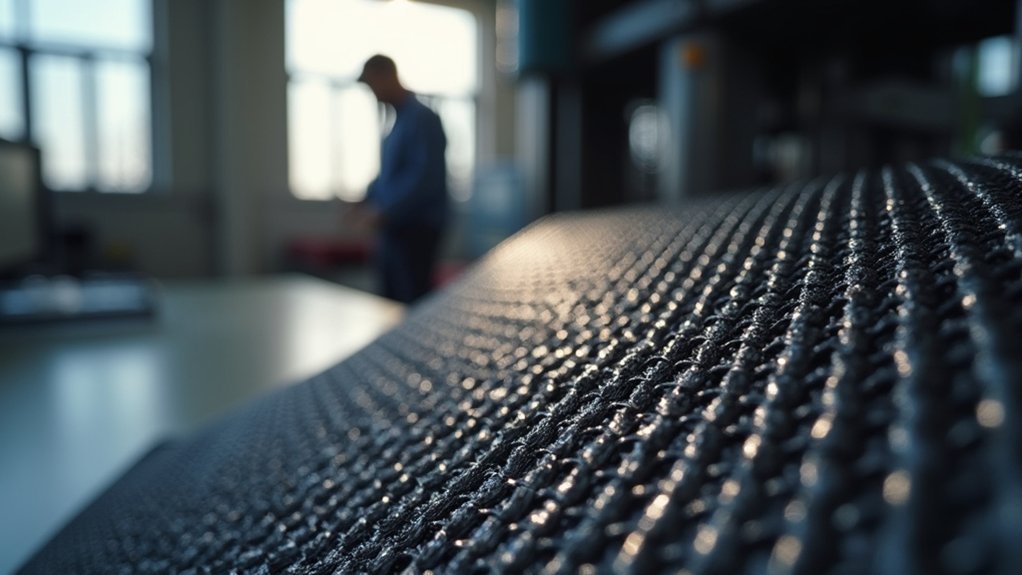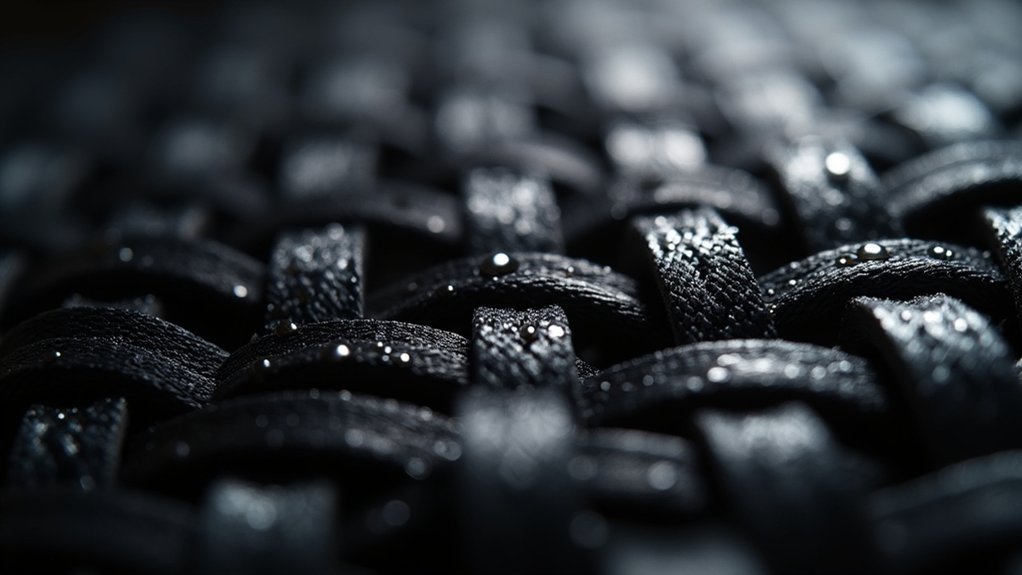Carbon fiber nylon’s incredible strength comes from two key factors working together. You’re getting nylon’s polyamide chains that form powerful hydrogen bonds between molecules, creating a naturally tough base material. Then carbon fibers distribute loads across the entire structure, preventing weak points and catastrophic failures. This combination delivers 8,340 psi tensile strength and makes the material 24 times stronger than ABS plastic. The science behind this performance reveals even more fascinating engineering advantages.
The Science Behind Carbon Fiber Reinforcement

When carbon fibers integrate into nylon’s polymer matrix, they create a remarkable transformation that fundamentally changes the material’s mechanical behavior.
You’re witnessing a process where chopped carbon fibers distribute throughout the nylon base, forming a high-strength composite that’s 24 times stronger and 27 times stiffer than traditional ABS materials.
The carbon fiber reinforcement works by distributing loads across the entire length of each fiber strand. This load distribution mechanism dramatically improves the material’s structural integrity and load-bearing capabilities.
You’ll find that the resulting composite maintains exceptional performance even under elevated temperatures, with a heat deflection temperature reaching 155°C.
The unique combination creates a high modulus material that absorbs vibrations and impacts while maintaining both toughness and flexibility.
How Nylon’s Molecular Structure Contributes to Strength
You’ll find that nylon’s strength originates from its polyamide chain architecture, where long polymer molecules create natural entanglements that boost tensile strength and flexibility.
The unique arrangement of amide groups enables hydrogen bonding between chains, creating powerful intermolecular forces that hold the structure together.
These hydrogen bonds form the backbone of nylon’s durability, establishing strong inter-chain interactions that enhance the material’s overall structural integrity.
Polyamide Chain Architecture
The backbone of carbon fiber nylon’s exceptional strength lies in its semi-aromatic polyamide molecular structure, which creates a rigid framework that resists deformation under stress. This polyamide chain architecture enables extensive intermolecular bonding throughout the material matrix. You’ll find that these molecular connections greatly enhance Nylon CF’s tensile strength and durability compared to standard thermoplastics like ABS or PLA.
| Property | Standard Nylon | Nylon CF |
|---|---|---|
| Tensile Strength | Moderate | High |
| Intermolecular Bonding | Limited | Extensive |
| Deformation Resistance | Basic | Superior |
| Durability | Standard | Enhanced |
| Thermal Stability | Good | Excellent |
The chain architecture’s design allows carbon fibers to integrate seamlessly within the polymer matrix, creating a composite that delivers exceptional strength-to-weight ratios while maintaining flexibility for impact absorption.
Intermolecular Hydrogen Bonding
As carbon fibers integrate into nylon’s polymer matrix, they amplify the material’s inherent hydrogen bonding network that forms between adjacent amide groups along the molecular chains.
You’ll find these hydrogen bonds create exceptional tensile strength, allowing the composite to withstand massive mechanical loads without breaking. The bonds also deliver remarkable flexibility and toughness, enabling your carbon fiber nylon components to absorb impacts and resist deformation under extreme stress.
This intermolecular bonding creates nylon’s semi-crystalline structure, balancing rigid crystalline regions with flexible amorphous areas.
When you combine carbon fibers with this hydrogen-bonded framework, you’re greatly boosting both strength and stiffness. The result is a composite material where carbon fiber reinforcement works synergistically with nylon’s molecular architecture to optimize overall performance.
Short vs. Continuous Carbon Fiber Integration

When you’re selecting carbon fiber nylon for your project, you’ll encounter two distinct fiber integration methods that dramatically affect performance.
Short chopped fibers boost strength and stiffness beyond traditional thermoplastics while delivering impressive impact resistance at 124 J/m², but they can’t match the load-bearing capabilities of their continuous counterparts.
Continuous fiber integration transforms the material into a metal-like performer that exceeds aluminum’s tensile strength while maintaining lightweight properties through strategic fiber placement.
Chopped Fiber Properties
While continuous carbon fibers offer superior load distribution, chopped carbon fibers provide a more accessible entry point into high-performance nylon composites.
You’ll find that chopped carbon fibers greatly boost nylon’s mechanical properties, delivering strength that’s 24 times greater than ABS and stiffness 27 times higher. The composite achieves exceptional impact resistance with a Notched Izod rating of 124 J/m², far exceeding PLA’s 27 J/m².
Key advantages you’ll experience include:
- Superior strength-to-weight ratio that exceeds 6061-T6 aluminum for lightweight applications
- Enhanced dimensional stability that reduces warping during printing processes
- Improved structural integrity for functional prototypes and end-use manufacturing parts
This reinforcement creates robust composites perfect for demanding engineering applications.
Continuous Strand Advantages
Beyond the impressive gains from chopped fibers, continuous carbon strands represent the pinnacle of nylon reinforcement technology. You’ll discover that continuous fiber creates uninterrupted load paths throughout your printed parts, dramatically outperforming short fiber alternatives. This integration delivers metal-like strength while maintaining lightweight characteristics that often surpass aluminum’s strength-to-weight ratio.
| Property | Short Carbon Fiber | Continuous Fiber |
|---|---|---|
| Load Distribution | Localized | Enhanced throughout length |
| Structural Integrity | Potential weak points | Maintains performance |
| Impact Resistance | Standard | Superior toughness |
You’ll achieve exceptional durability in high-load applications where traditional materials fail. The continuous strands effectively absorb stresses and eliminate the localized weaknesses common with chopped alternatives, making them ideal for aerospace and automotive innovations requiring both strength and weight optimization.
Impact Resistance: Why Nylon CF Outperforms Other Materials
The moment you need a material that can take a beating and keep performing, nylon CF stands head and shoulders above the competition.
With a Notched Izod Impact rating of 124 J/m², it crushes PLA’s measly 27 J/m² rating, delivering nearly five times superior impact resistance.
Carbon fibers transform nylon into a resilient powerhouse that absorbs impacts like a seasoned boxer taking punches.
You’ll find it maintains structural integrity under demanding mechanical loads that would destroy traditional materials.
Here’s why nylon CF dominates:
- Superior energy absorption – Carbon fibers distribute impact forces throughout the material structure
- Flexible durability – Prevents catastrophic failure while maintaining performance under stress
- Real-world applications – Perfect for aerospace components, automotive parts, drone frames, and protective gear
Tensile Strength vs. Toughness: Understanding the Difference

When engineers evaluate materials, they often confuse tensile strength with toughness—but understanding this distinction will make or break your project selection.
Tensile strength measures your material’s resistance to pulling forces before breaking. Carbon Fiber Nylon delivers impressive 8340 psi tensile strength, handling demanding stretching applications effectively.
Toughness represents your material’s ability to absorb energy and deform without fracturing. With a Notched Izod Impact rating of 124 J/m², Carbon Fiber Nylon markedly outperforms PLA’s 27 J/m² rating.
Here’s the key difference: if you’re designing components facing stretching forces, prioritize tensile strength. For shock-absorbing applications, toughness matters more.
Carbon Fiber Nylon’s balanced performance delivers both properties, making it ideal when you need durability plus dynamic load resistance without sudden failure.
Heat Deflection Properties and Temperature Resistance
When you’re evaluating Carbon Fiber Nylon’s thermal performance, you’ll need to understand three critical measurements that determine how it handles heat stress.
The Heat Deflection Temperature tells you the point where the material begins to soften under load, while long-term temperature limits define safe operating ranges for extended use.
You’ll also want to contemplate the thermal expansion coefficient, which affects how much the material grows or shrinks as temperatures change.
Heat Deflection Temperature
Understanding carbon fiber nylon’s heat deflection properties becomes essential when you’re selecting materials for high-temperature applications.
With a heat deflection temperature of approximately 155°C, this material considerably outperforms standard thermoplastics in demanding thermal environments.
You’ll find carbon fiber nylon maintains structural integrity across various temperature ranges:
- Long-term exposure: Reliable performance between 90°-120°C for extended operational periods
- Short-term applications: Withstands temperatures up to 150°C without deformation or failure
- Comparative advantage: Superior to PLA’s 54°C HDT, reducing warping and collapse risks
This exceptional heat deflection temperature makes carbon fiber nylon ideal for outdoor and industrial environments where temperature fluctuations occur regularly.
You can count on consistent performance even under thermal stress conditions.
Long-Term Temperature Limits
Since carbon fiber nylon’s heat deflection temperature establishes its short-term thermal capabilities, you’ll need to evaluate its long-term temperature limits for sustained operational success. The material’s long-term usage temperature ranges between 90°-120° C, ensuring reliable performance across various demanding environments.
| Temperature Range | Duration | Performance | Applications |
|---|---|---|---|
| 90°-120° C | Long-term | Best reliability | Automotive parts |
| Up to 150° C | Short-term | Maintains integrity | Industrial tooling |
You’ll find this thermal stability comes from carbon fiber nylon’s low thermal expansion coefficient of 0.5 x 10^-4/K, which minimizes dimensional changes during temperature fluctuations. Unlike PLA and PETG filaments, carbon fiber nylon won’t compromise structural integrity under sustained heat exposure, making it ideal for continuous-duty applications.
Thermal Expansion Coefficient
Carbon fiber nylon’s thermal expansion coefficient of 0.5 x 10^-4/K directly impacts its heat deflection properties, making it exceptionally stable across temperature variations.
This low expansion rate means you’ll experience minimal dimensional changes when your parts encounter temperature fluctuations, essential for maintaining precise tolerances in critical applications.
The thermal stability translates into three key advantages:
- Dimensional Accuracy – Parts retain their original measurements even when exposed to temperature cycling between ambient and elevated conditions.
- Reduced Warping Risk – The controlled expansion minimizes internal stresses that typically cause part distortion in other materials.
- Consistent Performance – Carbon fiber reinforcement works synergistically with the nylon matrix to maintain structural integrity throughout temperature ranges.
You can rely on this material for applications requiring both strength and thermal predictability.
The Role of Fiber-to-Matrix Bonding
When carbon fibers integrate with the nylon matrix, they create a bonding mechanism that’s essential for the composite’s exceptional strength characteristics. This fiber-to-matrix bonding allows carbon fibers to effectively transfer loads throughout the nylon matrix, considerably improving mechanical performance beyond what either material achieves alone.
You’ll notice this strong adhesion prevents fiber pull-out during stress, contributing to the material’s remarkable toughness and resilience. The bonding mechanism delivers a Notched Izod Impact rating of 124 J/m², showcasing superior performance compared to traditional thermoplastics like PLA.
Your printing parameters considerably influence bonding efficiency. Optimizing extrusion temperature and layer thickness enhances interlayer adhesion and fiber-to-matrix interaction, improving tensile strength while increasing resistance to deformation and failure under demanding mechanical loads.
Optimizing Print Parameters for Maximum Strength
Although achieving ideal strength in carbon fiber nylon requires understanding the fundamental bonding mechanisms, you’ll maximize performance by fine-tuning specific print parameters that directly influence mechanical properties.
Enhancing print parameters involves balancing multiple variables that affect structural integrity and material performance.
Key parameters for maximum strength include:
- Infill settings – Increase infill percentage to enhance ultimate tensile strength while selecting geometric patterns like hexagonal or triangular designs for best load distribution at lower densities.
- Temperature control – Maintain nozzle temperatures between 260°C and higher based on your specific filament formulation to improve layer adhesion without causing thermal degradation.
- Wall configuration – Implement increased wall thickness to boost tensile strength through enhanced structural integrity and reduced void formation that compromises material performance.
Infill Density and Wall Thickness Effects
Since structural integrity depends heavily on internal geometry, infill density and wall thickness serve as the primary determinants of your carbon fiber nylon part’s mechanical performance.
Higher infill density dramatically increases ultimate tensile strength by placing more material within your part’s structure. You’ll achieve ideal results with 40% infill density when using hexagonal or triangular patterns, while rectangular patterns require 55% density for comparable strength.
Wall thickness directly correlates with tensile strength—thicker walls provide greater structural integrity and deformation resistance. This thickness also enhances interlayer adhesion, preventing catastrophic part failure.
Thicker walls deliver superior tensile strength and enhanced interlayer adhesion, creating robust structural integrity that prevents catastrophic failure in carbon fiber nylon components.
When you optimize both parameters together, you’ll minimize defects like pores and voids that compromise mechanical properties. Strategic selection of infill density and wall thickness maximizes your carbon fiber nylon composite’s load-bearing capabilities.
Interlayer Adhesion and Structural Integrity
Beyond optimizing internal geometry, you must focus on interlayer adhesion to achieve maximum structural integrity in your carbon fiber nylon parts.
Strong bonding between layers prevents delamination and directly impacts your part’s tensile strength, especially critical for high-load applications. Poor interlayer adhesion creates weak interfaces that’ll compromise your printed part’s overall performance.
Three key factors control interlayer adhesion quality:
- Printing speed and platform temperature – Higher speeds can enhance tensile strength by promoting better layer fusion.
- Layer thickness optimization – Thinner layers provide superior adhesion through increased contact area between layers.
- Defect minimization – You’ll need to eliminate voids and pores that arise during printing, as these directly weaken interlayer adhesion and compromise mechanical performance.
Strength-to-Weight Ratio Advantages
When you’re designing parts that demand both structural performance and weight efficiency, carbon fiber nylon delivers an exceptional strength-to-weight ratio that’ll transform your engineering capabilities.
This composite material achieves strengths comparable to aluminum while maintaining considerably lower weight, enabling innovative designs previously impossible with traditional materials.
You’ll find the strength-to-weight ratio of carbon fiber nylon actually exceeds 6061-T6 aluminum in many applications, opening new possibilities for weight-critical projects.
The material’s enhanced stiffness—27 times greater than standard nylon—ensures efficient load distribution without adding bulk.
Carbon fiber nylon’s 27x stiffness improvement over standard nylon maximizes load distribution efficiency while eliminating unnecessary material bulk.
Whether you’re prototyping automotive components or manufacturing aerospace parts, this superior strength-to-weight ratio lets you reduce overall system weight while maintaining structural integrity under demanding conditions.
Comparison With Traditional Engineering Materials
To truly appreciate carbon fiber nylon’s performance advantages, you’ll want to examine how it stacks up against traditional engineering materials across key metrics.
Carbon fiber reinforcement transforms standard nylon into a powerhouse that outperforms established materials in multiple categories.
The performance comparisons reveal remarkable improvements:
- Strength comparison: Carbon fiber nylon delivers 24 times greater tensile strength than ABS and 27 times higher stiffness, while exceeding 6061-T6 aluminum’s strength-to-weight ratio.
- Impact resistance: With a Notched Izod Impact rating of 124 J/m², it greatly surpasses PLA’s 27 J/m² rating.
- Temperature performance: The 155°C heat deflection temperature considerably outclasses PLA’s 54°C limit.
This combination of superior strength, toughness, and thermal stability positions carbon fiber nylon as the preferred choice for demanding engineering applications.
Real-World Performance in Demanding Applications
Since carbon fiber nylon’s exceptional mechanical properties translate directly into real-world advantages, engineers across industries have deployed this material in applications where failure isn’t an option.
You’ll find carbon fiber nylon performing reliably in aerospace components that endure extreme temperature fluctuations and mechanical stress. Its 124 J/m² impact resistance prevents catastrophic failures in drone frames during harsh landings, while the 155°C heat deflection temperature guarantees automotive parts maintain integrity under hood environments.
When you’re manufacturing lightweight bicycle frames, this material’s ability to absorb vibrations without snapping becomes vital for rider safety.
The combination of 8340 psi tensile strength and dimensional stability makes carbon fiber nylon your go-to choice for functional prototypes that must perform like end-use parts.
Frequently Asked Questions
Is Carbon Fiber Nylon Strong?
You’ll find carbon fiber nylon exceptionally strong with 8340 psi tensile strength and 124 J/m² impact resistance. It’s tougher than PLA, handles high temperatures, and achieves strength-to-weight ratios exceeding aluminum.
What Makes Carbon Fiber so Strong?
You’ll find carbon fiber’s strength comes from its unique carbon atom arrangement, providing exceptional tensile strength of 8340 psi, excellent impact resistance, and lightweight properties that absorb energy while resisting deformation.
Is Carbon Fiber Nylon Stronger Than Pla+?
You’ll find carbon fiber nylon considerably stronger than PLA+ with 124 J/m² impact resistance versus PLA’s 27 J/m², plus superior heat deflection at 155°C compared to 54°C.
Is Carbon Fiber Nylon Stronger Than Aluminum?
You’ll find carbon fiber nylon isn’t stronger than aluminum in pure tensile strength, but it offers superior strength-to-weight ratios and impact resistance, making it competitive in lightweight applications.





Leave a Reply